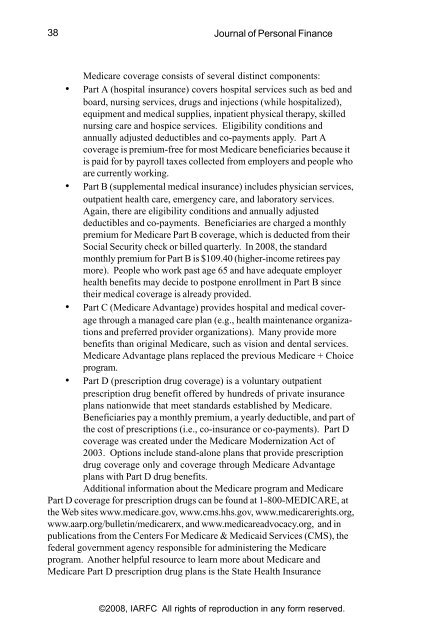3433-vol. 6 issue 2-3.pmd - iarfc
3433-vol. 6 issue 2-3.pmd - iarfc
3433-vol. 6 issue 2-3.pmd - iarfc
You also want an ePaper? Increase the reach of your titles
YUMPU automatically turns print PDFs into web optimized ePapers that Google loves.
38<br />
Journal of Personal Finance<br />
Medicare coverage consists of several distinct components:<br />
• Part A (hospital insurance) covers hospital services such as bed and<br />
board, nursing services, drugs and injections (while hospitalized),<br />
equipment and medical supplies, inpatient physical therapy, skilled<br />
nursing care and hospice services. Eligibility conditions and<br />
annually adjusted deductibles and co-payments apply. Part A<br />
coverage is premium-free for most Medicare beneficiaries because it<br />
is paid for by payroll taxes collected from employers and people who<br />
are currently working.<br />
• Part B (supplemental medical insurance) includes physician services,<br />
outpatient health care, emergency care, and laboratory services.<br />
Again, there are eligibility conditions and annually adjusted<br />
deductibles and co-payments. Beneficiaries are charged a monthly<br />
premium for Medicare Part B coverage, which is deducted from their<br />
Social Security check or billed quarterly. In 2008, the standard<br />
monthly premium for Part B is $109.40 (higher-income retirees pay<br />
more). People who work past age 65 and have adequate employer<br />
health benefits may decide to postpone enrollment in Part B since<br />
their medical coverage is already provided.<br />
• Part C (Medicare Advantage) provides hospital and medical coverage<br />
through a managed care plan (e.g., health maintenance organizations<br />
and preferred provider organizations). Many provide more<br />
benefits than original Medicare, such as vision and dental services.<br />
Medicare Advantage plans replaced the previous Medicare + Choice<br />
program.<br />
• Part D (prescription drug coverage) is a <strong>vol</strong>untary outpatient<br />
prescription drug benefit offered by hundreds of private insurance<br />
plans nationwide that meet standards established by Medicare.<br />
Beneficiaries pay a monthly premium, a yearly deductible, and part of<br />
the cost of prescriptions (i.e., co-insurance or co-payments). Part D<br />
coverage was created under the Medicare Modernization Act of<br />
2003. Options include stand-alone plans that provide prescription<br />
drug coverage only and coverage through Medicare Advantage<br />
plans with Part D drug benefits.<br />
Additional information about the Medicare program and Medicare<br />
Part D coverage for prescription drugs can be found at 1-800-MEDICARE, at<br />
the Web sites www.medicare.gov, www.cms.hhs.gov, www.medicarerights.org,<br />
www.aarp.org/bulletin/medicarerx, and www.medicareadvocacy.org, and in<br />
publications from the Centers For Medicare & Medicaid Services (CMS), the<br />
federal government agency responsible for administering the Medicare<br />
program. Another helpful resource to learn more about Medicare and<br />
Medicare Part D prescription drug plans is the State Health Insurance<br />
©2008, IARFC All rights of reproduction in any form reserved.
















